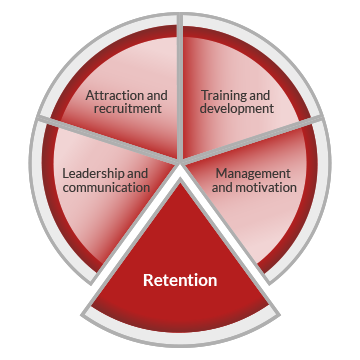Retaining skilled employees is important for a business because a high rate of employee turnover results in a loss of knowledge and skills. The financial cost of losing an employee includes both lost productivity and recruitment effort. You will have made a significant investment (both time and money) in attracting, recruiting, inducting, training and developing your employees. This effort will need to be replicated to replace the lost worker.
Research indicates that the cost of replacing an employee is around 1.5 times their annual salary.
(Stretton, rR2000, Mind the Gap, HR Monthly, Australian Human Resource Institute October, Pg. 54-55)
The Workforce turnover analysis template can help you calculate your turnover rate and the associated cost.
Why employees stay
Understanding why employees choose to stay in your business may help you reduce staff turnover. Often the reasons that employees remain are the same reasons that first attracted them to your business.
Some of the factors that influence people to stay in a business are detailed in the Employee retention table.
Why employees leave
Some of the factors that may influence an employee’s decision to leave their job include:
- poor management;
- unsatisfactory remuneration;
- issues with immediate supervisors (personality differences); and
- limited work-life balance.
If you’d like to know what your employees think about their workplace, use the Employee feedback survey template and do a survey of your employees. This will give you a good indication of the things that are working well in your workplace and aspects that you may need to improve on.
For more information and help with workforce retention, visit your local Jobs and Skills Centre.
Improving your retention rate
Strategies or initiatives you may wish to consider to improve your retention of valued employees could include:
- flexible work arrangements such as working off site, varied hours and salary sacrifice for additional leave;
- practices that support employees to balance work and caring responsibilities, such as additional parental leave, support for carers and employees who become seriously ill including extended unpaid leave;
- support for employees to pursue personal and professional development or study;
- providing a forum for staff to contribute new ideas and develop innovation in the workplace;
- providing high quality performance development, leadership opportunities, coaching and mentoring;
- employee assistance, workplace diversity, wellness and health programs;
- support for employees participating in local community and volunteering activities; and
- celebrations and recognition of organisational and personal achievements.
Use the Support and retain checklist to highlight the actions you may need to take to help you to retain and support employees in your own workplace.
Business.gov.au is an online Australian Government resource that provides useful information to attract and retain high quality employees through staff development and training.
Work-life balance initiatives
Offering flexible work-life balance initiatives in your workplace may assist you in retaining your current workforce and may greatly expand your available pool of potential employees.
Employees are seeking greater flexibility to balance diverse work and life choices. If one employer can’t meet their needs they will look for another that can.
(Heysman, M, 2007, Engaging Gen Y, HR Monthly, Australian Human Resources Institute, July, pg. 48–51)
Visit the Workplace Gender Equality Agency for some useful information about:
- work-life initiatives and how/why to implement flexible work strategies;
- workplace flexibility ideas for all employees; and
- strategies for achieving pay equity in Western Australia and improving the gender pay gap.
You could also check out the Better workplace guide for small business publication.
Before introducing any flexible work strategies that may change your working hours and leave provisions, check your legal obligations under the relevant state or national modern award.
If you don’t know which award applies to your business, call Wageline on 1300 655 366 and they can assist you to determine your employment obligations.
For additional information about legal obligations, you can contact the Fair Work Ombudsman on 13 13 94 or visit fairwork.gov.au.




